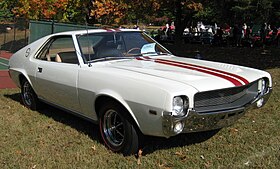AMC AMX
| AMC AMX | |
|---|---|

1968 AMX with "Go-Package"
|
|
| Overview | |
| Manufacturer | American Motors Corporation |
| Also called | Rambler AMX (Australia) |
| Production | 1968–1970 |
| Assembly | |
| Designer | Richard A. Teague |
| Body and chassis | |
| Class | Grand tourer, Muscle car, Sports car |
| Body style | 2-door coupe |
| Layout | FR layout |
| Platform | AMC’s “junior cars” |
| Powertrain | |
| Engine |
|
| Transmission | |
| Dimensions | |
| Wheelbase | 97 in (2,464 mm) |
| Length |
|
| Width | 71 in (1,803 mm) |
| Height | 51 in (1,295 mm) |
| Curb weight | Approximate: 3,000 lb (1,361 kg) |
The AMC AMX is a two-seat GT-style sports car that was produced by American Motors Corporation for the 1968 through 1970 model years. The AMX was also classified as a muscle car, but "unique among other American cars at the time due its short wheelbase". The AMX was also the only American-built steel-bodied two-seater of its time, the first since the 1955-1957 Ford Thunderbird. To a degree, the AMX was a competitor with America's only other two-seater of the era, the Chevrolet Corvette for substantially less money. With a one-inch (2.5 cm) shorter wheelbase than Chevrolet's two-seater, the AMX was often seen by the press as a "Corvette competitor"
Fitted with the optional high-compression medium block 390 cu in (6.4 L) AMC V8 engine, the AMX offered top-notch performance at an affordable price. In spite of this value and enthusiastic initial reception by automotive media and enthusiasts, sales never thrived. However, the automaker's larger objectives to refocus AMC's image on performance and to bring younger customers into its dealer showrooms was achieved. After three model years, the two-seat version was discontinued, and the AMX's now signature badging was transferred to a high-performance version of its four-seat sibling, the Javelin, from 1971-1974.
American Motors capitalized the respected reputation of the original AMXs by reviving the model designation for performance-equipped coupe versions of the compact Hornet in 1977, Concord in 1978, and the subcompact Spirit in 1979 and 1980.
The AMX name originates from the "American Motors eXperimental" code used on a concept vehicle and then on two prototypes shown on the company's "Project IV" automobile show tour in 1966. One was a fiberglass two-seat "AMX", and the other was a four-seat "AMX II". Both of these radically styled offerings reflected the company's strategy to shed its "economy car" image and appeal to a more youthful, performance-oriented market.
...
Wikipedia
